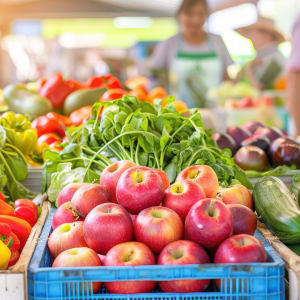 Supporting small, local businesses is one of the best ways to strengthen your community and boost the local economy. Shopping small doesn’t stop at choosing a local hardware store over a big chain or dining at a family-owned café instead of a national franchise. It also means buying food directly from local sources.
Supporting small, local businesses is one of the best ways to strengthen your community and boost the local economy. Shopping small doesn’t stop at choosing a local hardware store over a big chain or dining at a family-owned café instead of a national franchise. It also means buying food directly from local sources.
Locally Grown Food Bursts with Flavor
When food is grown, purchased, and consumed locally, it can be harvested at peak ripeness rather than prematurely picked for long-distance shipping. I learned this firsthand during my first visit to Riggs Orchard, where I ate a peach straight off the tree. That peach was life-changing—so much so that the memory still haunts me every time I bite into a store-bought peach. Many fruits and vegetables at local markets are harvested within 24 hours of being sold, making them undeniably fresher and more flavorful.
Eating Local Means Eating Seasonally
While we have access to nearly any fruit or vegetable year-round, that doesn’t mean they’re at their best. Crops grown out of season rarely deliver on flavor. As much as I love grapefruit, a summer grapefruit will never be as satisfying as one harvested in winter, no matter how badly I want it to be. Seasonal produce, grown and enjoyed in its natural cycle, is simply more vibrant and delicious.
Local Food is Packed with Nutrients
The shorter the journey between harvest and plate, the higher the nutrient value of your food. Local produce doesn’t endure long trips, extended storage, or time in distribution centers like imported goods often do. Think about it: after a long journey, don’t you feel a little worn out? The same goes for that tomato.
Buying Local Strengthens the Economy
When you purchase from local farmers and growers, the money stays within your community. It’s reinvested in local businesses and services, creating a ripple effect that benefits everyone.
Local Food is Better for the Environment
Choosing locally grown food helps preserve farmland and open spaces in your area. It also reduces the environmental impact of long-distance transportation, lowering your food’s carbon footprint.
Local Foods Support a Safer Food Supply
The fewer steps between you and your food’s source, the fewer opportunities there are for contamination. Buying directly from local growers ensures a cleaner, safer supply chain.
Local Growers Share Their Stories
Another benefit of eating local? The growers. Visiting Riggs Orchard didn’t just teach me how peaches are grown—it gave me a deep appreciation for the process. Mr. Riggs shared more about peach pits than I ever thought possible, and now I have a conversation starter for life: “Did you know the interesting thing about peach pits is…?” Local farmers and producers are passionate about their work and happy to share their knowledge. All you have to do is ask.
Eating local isn’t just about food; it’s about connection. It’s an opportunity to enjoy fresher, more flavorful ingredients, support your community, and learn about where your food comes from. So, next time you shop, consider skipping the supermarket and heading straight to the source. You—and your taste buds—will be glad you did.
By Ryanne Harper



